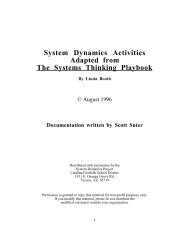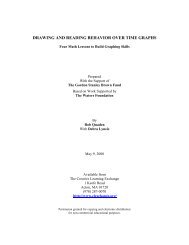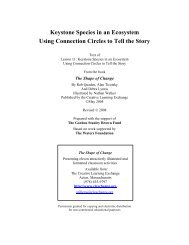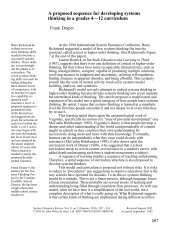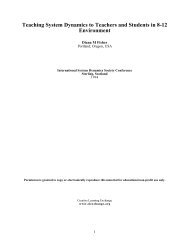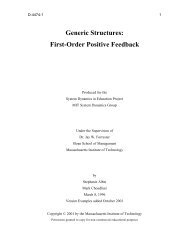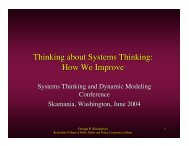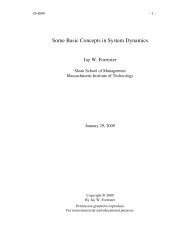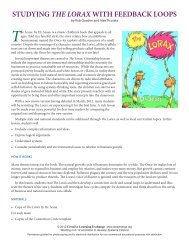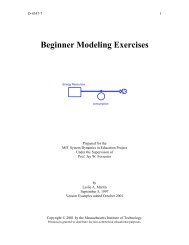System Dynamics in K-12 Education: Lessons Learned - Creative ...
System Dynamics in K-12 Education: Lessons Learned - Creative ...
System Dynamics in K-12 Education: Lessons Learned - Creative ...
Create successful ePaper yourself
Turn your PDF publications into a flip-book with our unique Google optimized e-Paper software.
dra<strong>in</strong>ed the stock of SD tra<strong>in</strong>ed and committed teachers, caus<strong>in</strong>g a steady erosion <strong>in</strong> student skills<br />
as well. Also, new demands have left little time or support for collaboration on systems lessons.<br />
Still, some good programs endure. For example, all eighth grade students will cont<strong>in</strong>ue to use<br />
behavior over time graphs, stock/flow diagrams and causal loops to structure their<br />
<strong>in</strong>terdiscipl<strong>in</strong>ary ecology research projects. This collaboration among all eighth grade teachers<br />
and their students will culm<strong>in</strong>ate <strong>in</strong> student presentations to the public at the annual EcoFair.<br />
Carlisle: <strong>Lessons</strong> <strong>Learned</strong><br />
We learned that young students can learn the basics of system dynamics, and that system<br />
dynamics can enrich their educational experience by mak<strong>in</strong>g it more learner-centered, engag<strong>in</strong>g,<br />
cohesive and relevant. <strong>System</strong> dynamics works best under certa<strong>in</strong> conditions: it complements<br />
the current curriculum, classroom teachers are <strong>in</strong>volved <strong>in</strong> design<strong>in</strong>g the lessons for their own<br />
students, every lesson <strong>in</strong>cludes hands-on experiential learn<strong>in</strong>g <strong>in</strong> teams, and students construct a<br />
solid understand<strong>in</strong>g of the math underp<strong>in</strong>n<strong>in</strong>gs at their level. It is also important that lessons<br />
build on one another <strong>in</strong> small <strong>in</strong>crements with lots of practice, so that students (and teachers) are<br />
not overwhelmed or misled. F<strong>in</strong>ally, lessons must be based on good system dynamics practice.<br />
We encountered two major hurdles to <strong>in</strong>fus<strong>in</strong>g system dynamics <strong>in</strong>to K-<strong>12</strong> education: first,<br />
learn<strong>in</strong>g system dynamics is hard, and, second, <strong>in</strong>stitut<strong>in</strong>g any change <strong>in</strong> education is even<br />
harder. While students eagerly plunge <strong>in</strong>to system dynamics, it is not so easy for many teachers<br />
because it requires time, math/computer facility, and a compell<strong>in</strong>g reason to change the way they<br />
th<strong>in</strong>k, teach and work together. <strong>System</strong> dynamics is not another teach<strong>in</strong>g tool that can be picked<br />
up at a workshop, nor is it just a software package. It is a broader and deeper problem-solv<strong>in</strong>g<br />
approach that is learner-centered, <strong>in</strong>quiry-based and constructivist. Teachers, therefore, not only<br />
need to learn and teach unfamiliar math and SD concepts, they also need to structure their<br />
teach<strong>in</strong>g to foster learner-centered learn<strong>in</strong>g – daunt<strong>in</strong>g challenges requir<strong>in</strong>g time, patience,<br />
support, and a strong desire for change.<br />
Fortunately, <strong>in</strong>novative teachers are drawn to SD when they observe its benefits to students. In<br />
Carlisle, hav<strong>in</strong>g systems mentors was a big help because classroom teachers could have on-go<strong>in</strong>g<br />
curriculum support and the chance to work with colleagues. Also, Quaden, Ticotsky and D.<br />
Lyneis worked through Road Maps together and relied on J. Lyneis for help with SD questions,<br />
but there is so much more to learn, and SD is not easy. Teachers are already pressed for time.<br />
If we could have foreseen the limited time and resources available, we might have done th<strong>in</strong>gs<br />
differently to address the difficulty for teachers learn<strong>in</strong>g SD. The pr<strong>in</strong>ciples of system dynamics<br />
unified the school experience for students by giv<strong>in</strong>g them <strong>in</strong>terdiscipl<strong>in</strong>ary problem-solv<strong>in</strong>g<br />
skills embedded <strong>in</strong> a learner-centered, collaborative approach, but perhaps we moved too fast <strong>in</strong><br />
try<strong>in</strong>g to <strong>in</strong>fuse system dynamics <strong>in</strong> too many places at first. Rather than reach out to all<br />
teachers, we should have <strong>in</strong>vested all our resources <strong>in</strong> the <strong>in</strong>novative early adopters already<br />
<strong>in</strong>cl<strong>in</strong>ed toward learner-centered teach<strong>in</strong>g, built their SD skills, and developed a larger body of<br />
lessons for their students. It may have been better to focus on students <strong>in</strong> fourth grade and older<br />
rather than <strong>in</strong>clude the primary grades where teachers are necessarily consumed with basic<br />
literacy. We also might have focused on math and science lessons at first where the connection<br />
<strong>Creative</strong> Learn<strong>in</strong>g Exchange<br />
www.clexchange.org<br />
8



